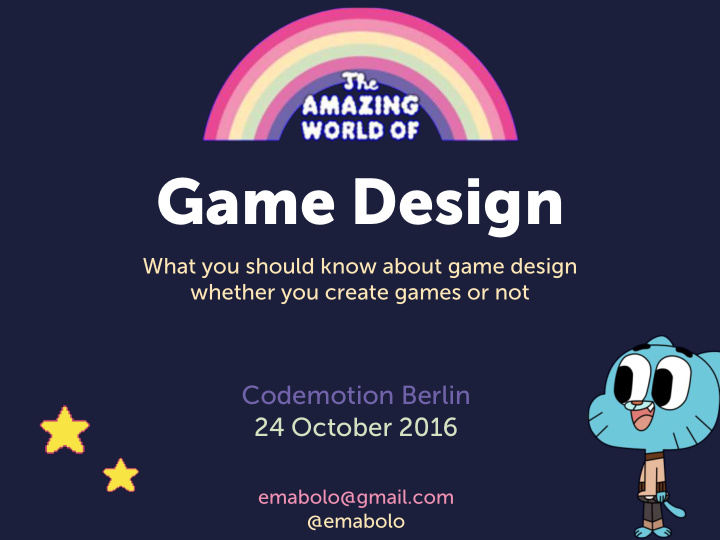



Game Design What you should know about game design whether you create games or not Codemotion Berlin 24 October 2016 emabolo@gmail.com @emabolo
Emanuele Bolognesi emabolo@gmail.com http://emabolo.com @emabolo www.gamearena.io www.gamesnostalgia.com www.gamesvoyager.com www.gameborder.net
1
2 You do not talk about game design
3
Game vs Toy
Game vs Toy
What is a game? 1. Games have goals 2. Games can be won and lost 3. Games have rules 4. Games are interactive 5. Games have conflicts 6. Games have challenges
Jesse Schell, The Art of Game Design
Main components of game design
Aesthetics How your game looks, sounds and feels
No Man’s Sky (2016)
Monument Valley (2014)
Shadow of the Beast II (1990)
Warcraft III - Reign of Chaos (2002)
Monopoly (1935)
Story The sequence of events
The Secret of Monkey Island (1990)
Assassin’s Creed (2007)
Space Invaders
Technology What makes the game possible
Commander Keen (1990)
Mechanics • Procedures and rules • The goal of a game • The victory conditions • Actions that players can take Pacman (1980)
Pacman - Commodore 64 version (1983)
Tomb Raider (1996)
MDA Framework http://gangles.ca/2009/08/21/mda/
None of the elements is more re impo port rtant than the others rs More visible Right brain Left brain Less visible
The elements support a theme • Decide what your theme is • Use every means possible to reinforce that theme
The Goal: create an experience • A memorable experience! • What experience do I want the player to have? • How can my game capture the essence? • Find as many ways as possible to instill this essence into your game Jesse Schell, The Art of Game Design
Batman Arkham Knight (2015)
Sid Meier’s Colonization (1994)
Think about it… Game designers design experience UX designers (by definition) design experience !!!
Focus and balance
Focus • Clear goals • No distractions Mario Cart 8 (2014) • Direct feedback • Continuosly challenging
Balance Anxiety Challenges Boredom Skills
Balance
Rewards • Reward with feedbacks: they tell the players they are doing well • Rewards generate pleasure • In games there is no such thing as ”too much reward”
Product where I can see game design choices
Let’s take the standard home holiday services…
Airbnb
Think about learning languages…
And now let’s take Duolingo
First of all: easthetic Experience Points Difficulty level GOALS -> balance
Player Level Map + Badges
Let’s take the usual navigation/map service
Now let’s take Waze
First of all: easthetic
Player Levels and Ranks Cartoon-style Unlockable Graphics avatars
And it’s not just “empty” gamification: Reports from higher level players have greater influence When you level up, your experience of navigation changes and it even impacts other “players”
Final thoughts • Give goals and rewards to your users • Balance the difficulty to keep the user in the flow • Give memorable experiences to your users • This is true for both games and non-games
That’s enough! Max Payne (2001)
Thank You! Email em emabolo@g @gmail.com Twitter @em @emabolo Skype em emabolo We Websi site www. www.emabolo.com
Email em emabolo@g @gmail.com Twitter @em @emabolo Skype em emabolo We Websi site: : www. www.emabolo.com
BACKUP
Game Design? Crafting the Rules of Entertainment
The goal: create an experience Sid Meier’s Colonization (1994)
Elite II – Frontier (1993)
A game is made of games Tetris (1988) Tomb Raider (2013)
Definition “A game is a problem solving activity, approached with a playful attitude” Jesse Schell, The Art of Game Design
Character Design • Research • Decide the target • Give him/her an interesting personality • Exaggerate characteristics • Make it distinctive • Colours • Goals and dreams • Back stories http://pixar-animation.weebly.com/character-design.html
A theme with resonance • What is about my game that feels powerful and special? • When I describe my game to people, what ideas get them really excited?
How to start
The Eight Filters 1. Artistic: does this game “feel” right? 2. Demographics: Will the target like this game enough? 3. Experience: is this a well designed game? 4. Innovation: is this game novel enough? 5. Business and marketing: Will this game sell? 6. Engineering: is this technically possible? 7. Social: does this game have a social/community goal? 8. Playtesting: do the playtesters enjoy the game enough?
Clash of Clans (2012) http://freemiumgamedesigns.com/2014/09/clash-of-clans-vs-boom-beach-part-2-the-habit/
The rule of the loop 1. Create a basic design 2. Find out the greatest risks in your design 3. Build prototypes that mitigates those risks 4. Test the prototypes 5. Learn from the tests and create a better design 6. Return to step 2
Know your audience
Leblanc’s Taxonomy of game pleasures • Sensation see or hear something beautiful, deliver pleasure • Fantasy imagining yourself as something you are not • Narrative dramatic unfolding of sequence of events • Challenge one of the core pleasure • Fellowship friendship and cooperation • Discovery explore the game world, discover new things • Expression creating new things • Submission leave your real world and enter a new set of rules and meaning: the magic circle
Bartle’s Taxonomy of Player Types
http://stories.maker.me/monument-valley-an-apple-design-award-winning-game/
Recommend
More recommend